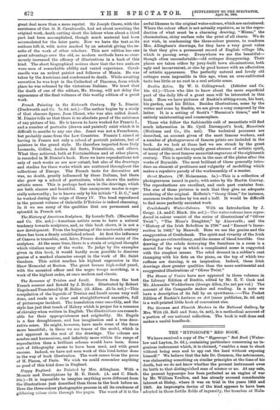and a number of portraits (drawn and painted) exist which
it is difficult to ascribe to any one else. Janet was not a Frenchman, but probably came from the Low Countries. Francis L aimed ut having in France not only a school of portrait painters, but of painters in the grand style. Ho therefore imported from Italy Leonardo, Cellini, Andrea del Santo, Primaticcio, and others. What they achieved, both at Fontainebleau and at other places, is recorded in H. Dimier's book. Here we have reproductions not only of such works as are now extant, but also of the drawings and studies for these works which are scattered throughout the collections of Europe. The French taste for decorative art was, no doubt, greatly influenced by these Italians, but them also grew up a school of portraiture, which shows the native artistic, sense. This is perhaps best seen in the drawings, which are both sincere and beautiful. One anonymous master is espe- cially noteworthy ; lie is known only by his initials "L D. C.," and he worked during the reign of Henry IV. The head reproduced in the present volume of Gabrielle D'Estrees is indeed charming. In it we see many of the qualities that are permanent and splendid in French art.
The History of American Sculpture. By Lorado Taft. (Macmillan and Co. 25s. net.)—American artists seem to have a natural tendency towards sculpture, and, as this book shows, it is not a new development. From the beginning of the nineteenth century there has been a firmly established school. At first the influence of Canova is traceable, and, later, France dominates many of the sculptors. At the same time, there is a strain of original thought which vitalises many of the works. To judge by the examples given in this book, it would hardly seem possible to discover genius of a marked character except in the work of Mr. Saint Gaudens. This artist reaches his highest expression in the Shaw Memorial at Boston. The great bronze high-relief panel, with the mounted officer and the negro troops marching, is a work of the highest order, at once modern and classic. Great Masters. (W. Heinemann. 5s.)—This is a collection of photogravures issued in parts, with notes by Sir Martin Conway. The reproductions are excellent, and each part contains four. The size of these pictures is such that they give an adequate rendering of the original. Holbein's "Georg GiSZef for instance, measures twelve inches by ten and a half. It would be difficult to find more perfectly executed work.
Cruikshank's Wafer-Colours. With an Introduction by T. Grego. (A. and C. Black. 20s. net.)—The water-colours here repro- duced in colour consist of the series of illustrations' of "Oliver Twist'; "The Miser's Daughter," by Ainsworth ; and the "History of the Irish Rebellion in 1798" and" EmmeVs Insur- rection in 1803," by Maxwell. Here we see the genius and the exaggeration of Cruilrehank. The spirit and vivacity of the Irish drawings are extraordinary, and the scenes of blood horrible. One arawing of the rebels destroying the furniture in a room is a marvel for the way in which a complicated scene is suggested with the simplest means. The rebel dressed in a soldier's coat thumping with his lists on the piano, on the top of which two ruffians are dancing, is an inspiration. Indeed, these Irish drawings show greater qualities than the more sentimental and exaggerated illustrations of" Oliver Twist."
The Stones of Venice have now appeared in three volumes in the Library Edition of Ruskin, edited by Mr. E. T. Cook and Mr. Alexander Wedderburn (George Allen, 21s. net per vol.) The account of the Campanile makes sad reading. In a note we have a description of its fall by an eyewitness.—The Pocket Edition of Ruskin's Lectures on Art (same publisher, Is. tid. net) is a well-printed little book of convenient size.






















































 Previous page
Previous page